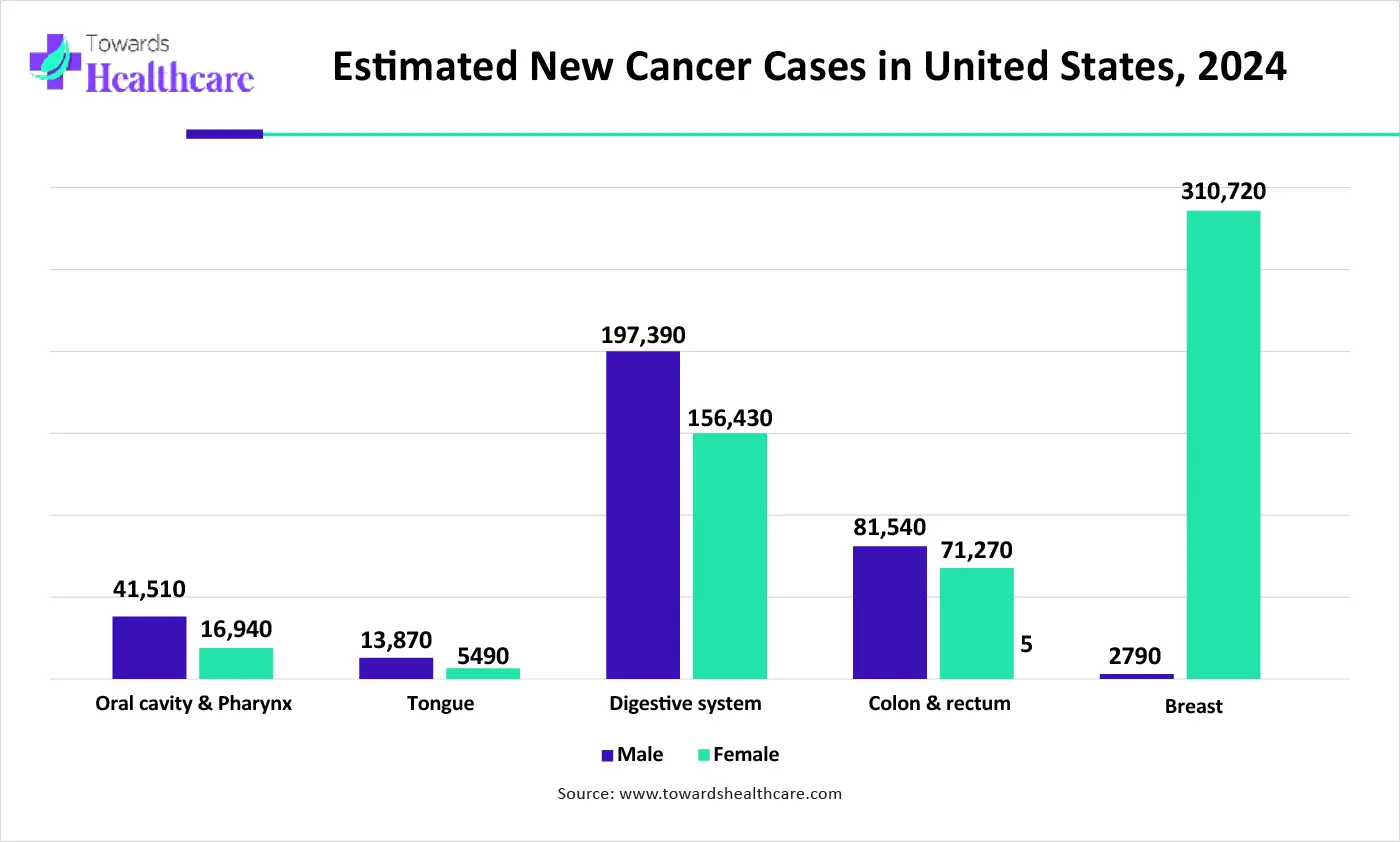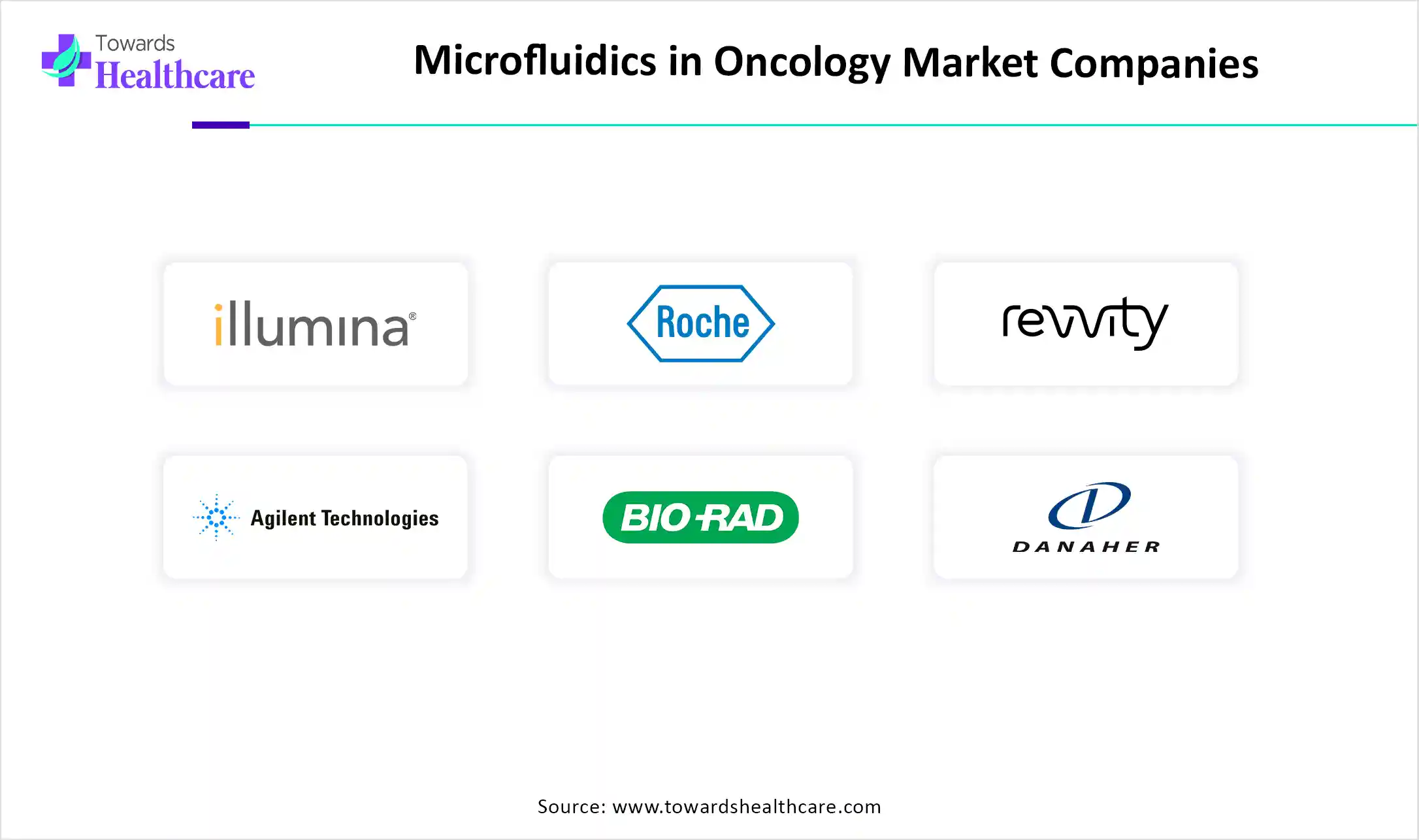November 2025

The global microfluidics in oncology market is on an upward trajectory, poised to generate substantial revenue growth, potentially climbing into the hundreds of millions over the forecast years from 2025 to 2034. This surge is attributed to evolving consumer preferences and technological advancements reshaping the industry.
The microfluidics in oncology market is rapidly expanding because it uses small devices to handle smaller amounts of fluids for cancer treatment and research. These systems support in testing of cancer drugs, the study of cancer cells, and the development of personalized cancer treatment. North America dominates the market due to the increasing demand for microfluidics systems driven by chronic diseases and the increasing prevention of cancer. While Asia Pacific is the fastest growing due to the advancement in technology, such as oncology-focused 3D culture and lab-on-chip techniques.
| Metric | Details |
| Market Growth | Projected high revenue from 2025-2034 driven by tech advancements and consumer demand. |
| Applications | Cancer drug testing, single-cell analysis, liquid biopsy, personalized treatment, metastasis study |
| Trends | Okomera's AI-CRISPR platform, SMART’s CAR T-cell microfluidic chip, Deepcell’s AI-based analysis. |
| Drivers | High precision, low sample volume, non-invasive diagnostics, early cancer detection tools. |
| Regional Growth | North America: R&D hub, rising cancer cases. Asia Pacific: Fastest growth, biotech investment. Europe: Rapid diagnostics, tech innovation. |
The microfluidics in oncology market is growing rapidly because this technology has emerged as a promising tool in cancer studies, such as modelling angiogenesis, single cancer cell analysis, liquid biopsy, drug screening, and metastasis. Microfluidic technologies create novel opportunities to study tumors in the preclinical and clinical settings. It provides many advantages, like a low sample volume, cost-effectiveness, parallelization, and portability. This platform offers more valuable technology in cancer research, specifically for prognosis and diagnostics purposes, and has been successfully employed in recent years. Microfluidic technology provides a non-invasive substitute for cancer diagnosis and management because of its higher sensitivity, high throughput, less material consumption, lower cost, and accurate liquid controlling abilities, driving the growth of the market.

AI integration in microfluidics in oncology is driving the growth of the market, as increasing interest in AI-based technologies in the field of microfluidics. The incorporation of artificial intelligence (AI) into microfluidics entails the automation of tasks that conventionally demand human intelligence. This AI integration capitalizes on the sharp speed it brings to the operation, design, and analysis of microfluidic experiments. The merging of AI and microfluidics provides promising approaches for improving the capabilities and efficiency of microfluidic devices in various applications. AI covers a broad range of techniques and approaches aimed at emerging intelligent systems. Incorporation of AI in microfluidics creates an authoritative platform for rapid detection in cancer analysis, improving accuracy, sensitivity, and real-time data processing.
Recent Technology Advancement
Microfluidic technology enables the manipulation of fluids at a micron scale, serving as a powerful tool for the early diagnosis of cancer. It executes intricate laboratory techniques on a microchip with exceptional precision and efficiency, demonstrating that this platform offers a reliable and straightforward method for isolating single cells without labeling. This capability is essential for researching specific therapeutic targets in cancer cells and cell-derived products. Furthermore, the technology is beneficial for discovering therapeutic targets and monitoring treatment responses. Microfluidic devices can isolate individual tumor cells, facilitating genomics, transcriptomics, and metabolomics analysis, which drives the growth of the microfluidics market in oncology.
Major Challenges of Microfluidic Systems
Traditional microfluidic systems frequently face challenges in producing a diverse range of drug concentrations, particularly for combinatorial drug screening. Many are limited to single-drug dilutions or linear gradients, which constrain their use in complex drug testing situations, thereby hindering the advancement of microfluidics in the oncology market.
Recent Advancements in Microfluidic-based Cancer Immunotherapy-on-a-chip (ITOC)
Microfluidic-based cancer immunotherapy-on-a-chip (ITOC) systems have been created to assist researchers in mimicking the tumor microenvironment and immune system. Various microfluidic platforms can be utilized for diverse on-chip functions pertinent to early clinical cancer immunotherapy processes, such as enhancing immune checkpoint blockade therapy, analyzing immune cell dynamics, assessing cytotoxicity, and developing vaccines or organoid models from patient samples. This method enables researchers to evaluate different immunotherapies, including immune checkpoint blockade and cell-based therapies, in a setting that is more physiologically relevant than conventional cell culture techniques, thus opening up new opportunities in the microfluidics oncology market.
North America is dominant in the microfluidics in oncology market with the largest revenue share, due to strong presence top research institute in North America, this institute manage various function of healthcare system including program development, management of clinical trial pipeline, governing affairs, quality assurance, contract and budget co-operation, data integrity, financial reporting, healthcare coverage analysis, patient recruitment, and site management which also driving the innovation of microfluidics services. Increasing rates of cancer in younger generations, which raises an urgent requirement for early cancer prevention strategies, increases the demand for innovative and advanced treatment solutions such as microfluidics technology, which contributes to the growth of the market.
For Instance,
In the U.S., growing government and private funding for cancer research, total U.S. philanthropic funding for cancer research is estimated at a few billion dollars annually, spread across hundreds of organizations. For Instance, the American Cancer Society invested over $132 million in new cancer research. Also presence of a favourable regulatory environment for cancer, like the National Cancer Institute (NCI), and the FDA's Oncology Center, which drives the growth of the market.
The increasing Canadian healthcare innovation includes the adoption of advanced therapies of cancer, increasing healthcare start-ups and a strong presence of biotech key players which increases spending for advanced microfluidic research and offer innovative products or services, these factors contribute to the growth of the market.
The Asia Pacific region is projected to experience the fastest growth in the microfluidics in oncology market during the forecast period, due to increasing Investment in biotech sector in the Asia Pacific region this growth is being driven by various factors, containing growing demand for novel drugs and therapies, the rise of precision medicine, and development in recent technology. Significantly increasing incidence of cancer has occurred over the past few years in the Asia-Pacific region. Therefore, cancer is a leading cause of death in Taiwan, South Korea, Singapore, Hong Kong also in urban China, and has become a main challenge for numerous healthcare systems in the Asia-Pacific region. Addressing these challenges increases demand for microfluidic solutions.
China’s healthcare industry is experiencing huge advancement, driven by increasing incomes, growing health awareness, and a rising aging population. China’s healthcare sector is among the largest and fastest-growing industries in the Asia-Pacific region. The rise in demand for modern healthcare and services is driving growth in the oncology healthcare sector. Increasing burden of cancer in China due to the aging population, greater awareness of cancer prevention among the public, and enhanced access to healthcare services, these factors also drive the growth of the market.
The Indian medical care sector is increasing because of its strengthening health coverage, services, and growing spending by the public as well as private biotech players. Also, increasing government support to the biotech industry of India. For instance, in January 2025, more than 73 crore Ayushman Bharat Health Accounts (ABHA) have been created successfully, and there are more than 5 lakh health professionals registered, which contributes to the growth of the market. In India Microfluidics sector is increasing traction in upcoming years, due to the consistent ongoing research in the sector and growing applications in cancer discovery, which causes the growth of the market.
Europe is expected to grow significantly in the microfluidics in oncology market during the forecast period, as increasing demand for fast diagnostics procedures, developments in microfabrication technology, and growing healthcare investment by the government drive the market growth. Recent innovations in microfabrication, like photolithography and 3D printing, are creating microfluidic devices further sophisticated and accessible in Europe, which contributes to the growth of the market.

In December 2024, Emulseo CEO, Florine Maes., “As a young innovative company, Emulseo is extremely proud to partner with a European industry leader such as Syensqo with a clear ambition to help innovation and to contribute to the development of modern technologies in the health care sector.” (Source - fibre2fashion)
By Region
According to market projections, the serum gonadotrophin API sector is expected to grow from USD 131 million in 2024 to USD 202.93 million by 2034, re...
November 2025
November 2025
November 2025
November 2025